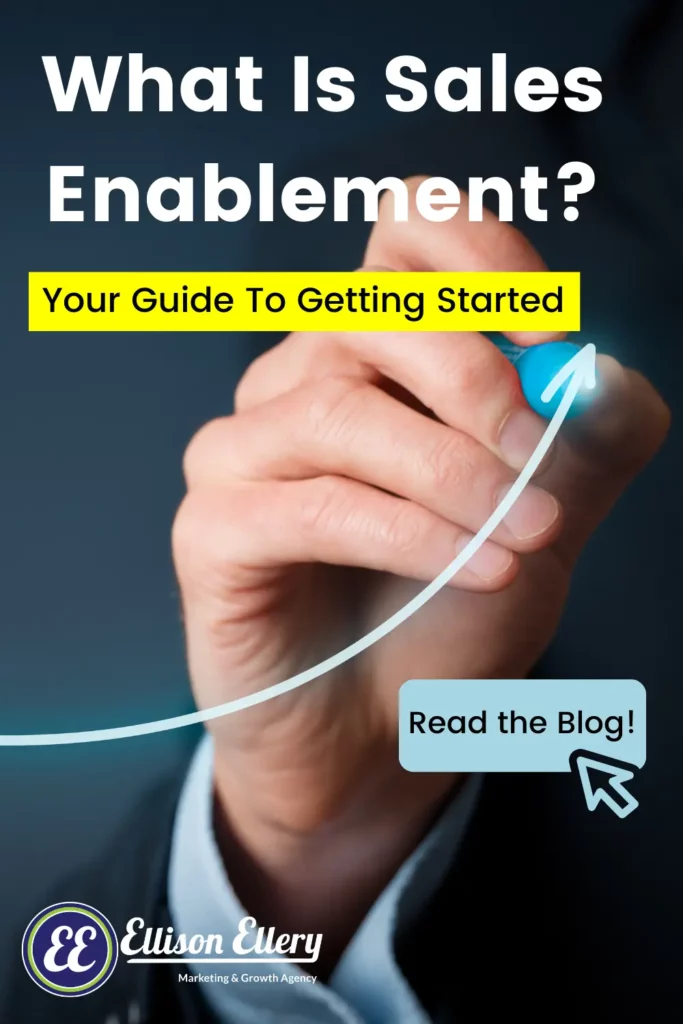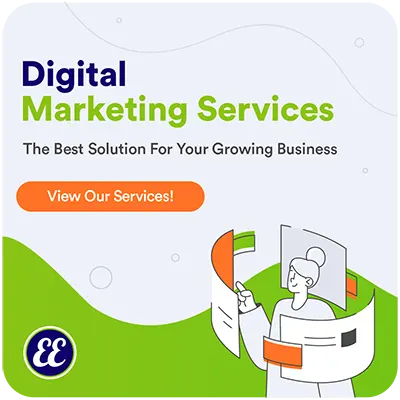Every business recognizes the importance of a sales strategy, but they also know that a solid sales plan is only as good as the sales reps making it happen. That’s why business owners develop sales enablement training to better equip their sales team to complete sales successfully.
Nurturing leads towards making a purchase requires a lot more than just pitch decks and call scripts. If you really want your sales team to knock every pitch out of the park you should align their strategy with your marketing team, who can provide valuable insight and content.
At Ellison Ellery, we help businesses leverage strategy and technology to make smarter marketing decisions that address their customers’ needs and ultimately bring in more sales. Let’s take a look at how to create sales enablement plans that optimize interactions between Sales and Marketing and help your business run more smoothly.
Table of Contents
What is Sales Enablement?
First we’ll dive a little deeper into the sales enablement definition to better explain why you should dedicate your valuable time to doing it.
In actuality, it will probably look different for every organization. But at its core, sales enablement is the process of providing materials to a team of sales professionals with the goal of helping them sell better, faster, and smarter.
76% of organizations see an increase in sales between 6% and 20% by implementing a solid sales enablement strategy.
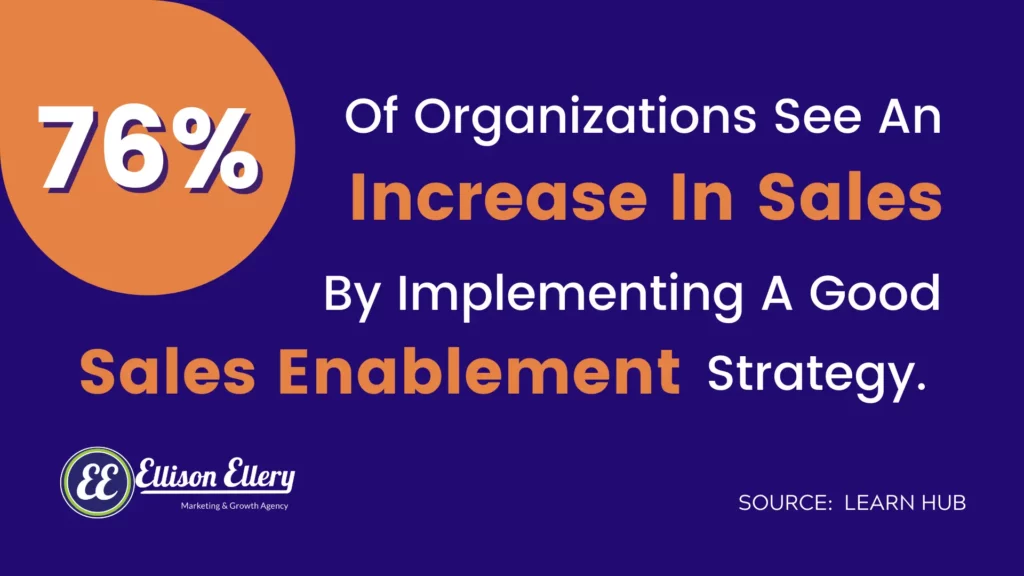
Customer-facing roles require confidence and knowledge of the product or service being sold. Sales enablement training equips those in customer-facing roles with the tools they need to effectively and efficiently engage with buyers.
What are some of the sales enablement tools you can provide?
- Content: Resource materials that outline the ins and outs of your product/service
- Programs/Software: Sales enablement platforms can store resources, help salespeople prepare customer materials, or keep buyer information organized.
Advanced tools now make it possible to easily prepare sales teams to sell confidently and successfully. They handle some of the administrative and research tasks so the sales employee can focus on providing positive customer experiences and making sales.
Your sales enablement strategy depends on your core audience, their awareness, and your sales team’s feedback on what works and what doesn’t.
Making A Sales Enablement Strategy
As marketers, we know that personalized content is what consumers want to see– if something doesn’t interest them specifically, it won’t hold their attention for long or even at all.
The same thing goes for sales! Sellers need to personalize their pitch so it speaks directly to the buyer they’re talking with… or risk losing them early on.
With good sales enablement strategies, salespeople are empowered to bolster predetermined content and brand guidelines with personalized buyer information to help them make the sale.
So essentially, sales enablement is owned by both marketing and sales teams and helps them work together more effectively.
Like we said, this may look different from company to company, but here are some sales enablement best practices to get you started.
Newsletter Sign up!
Get our best content on digital marketing in your inbox 2 times a month
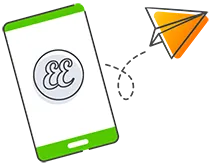
Elements Of A Sales Enablement Strategy
Sales enablement isn’t a one-size-fits-all approach, but it is a must-have strategy if you want to grow your business. Depending on your business, sales process, and existing content, it could differ for each organization. It sounds great in theory, but how do you put it into practice?
Here are three components to consider when implementing your own sales enablement strategy:
1) Sales Training
It’s worth investing the time and resources into proper training for your sales reps. No matter how long they’ve been with your organization or part of the sales game, there’s always something new to learn in an evolving business world.
Onboarding and training are not the same thing. Sure, all new salespeople will go through an onboarding process to learn how your organization works and get some initial sales content from you.
But you should have and encourage participation in continuous learning. If you’re worried about quick turnaround of sales team members, look at it this way:
If sales reps don’t feel that they’re learning and growing in your organization, you risk losing up to 60% of them within four years.
Sure, it might be frustrating to spend hours on training, just for an employee to leave. But not doing so only increases the odds that they’ll leave.
Effective, up-to-date training ensures a higher chance of productivity, performance, and confidence. Happier sales employees stick around longer!
If you’re in charge of sales enablement, it’s up to you to make sure that training materials are up to date. Analyze current practices and know what’s working and what you could do without.
Craft the perfect sales enablement strategy
Not sure if your sales enablement strategy is actually helping your team close sales? We excel in building strategies tailored to your business, and we'll create alignment between your sales and marketing teams through training, technology, and content.
2) Technology
There’s a lot to keep track of with sales enablement. Good news is, you can easily leverage modern technology to help you out. Implementing the right CRM tools and content management systems helps improve accuracy and transparency among sales and marketing teams.
Here are some examples of how technology can help the sales enablement process:
- Automatically send content at the right time to people who need it
- Train sales reps
- Organize all of the sales content
- Track customer behavior and find sales patterns
- Merge with CRM to give more insights
With insight into customer data on both sides (marketing and sales), it’s easier to engage in more delightful conversations with customers and truly drive results. Utilize technology here to really get the most out of your plan.
3) Content Optimization
Providing your sales team with the most helpful content for tough conversations or a specific audience is critical. A healthy pile of case studies, pitch decks, pricing information and briefs covering competitors can help a salesperson feel way more prepared.
You want to equip the right people with the right information at the right time. Next we’ll spend some time talking about some of the best practices for optimizing your sales content so you can get that done.
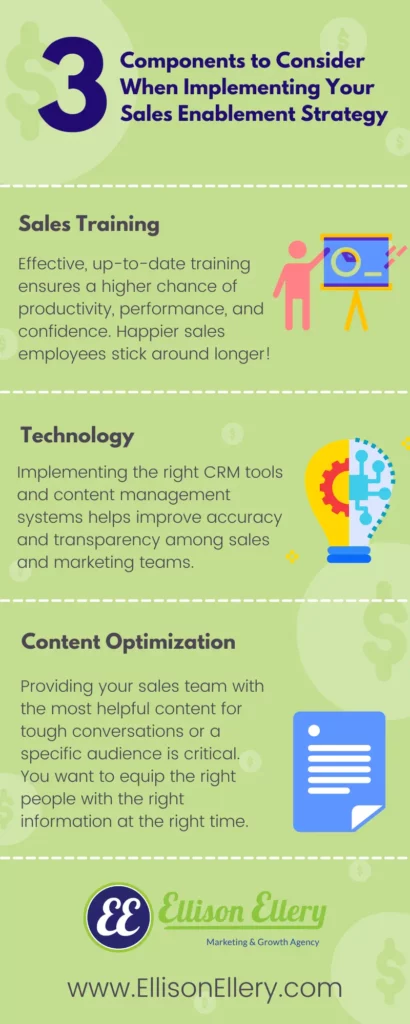
Creating Content That Helps With Sales
Whether you’ve worked in sales or not, it’s easy to imagine how frustrating it must be to know that there is a piece of content that will push a buyer to buy…and have no idea where to find it.
RingDNA has found that sellers spend 35 hours every month searching for or creating their own content. That’s far too much time!
What types of content should you have put together and organized to help sellers…well, sell?
- Product demo slide decks
- Informative blog posts
- One-pagers that answer prospective clients’ questions
- Case studies
- Whitepapers and e-books
- Pricing information
- Packets with competitor information
This isn’t an exhaustive list. With feedback from your sales team and the knowledge collected by your marketing teams you can determine which sales content will best help your business grow.
Which brings us to a key part of the content creation process…auditing.
Auditing Existing Content
Sales enablement isn’t something that can be done in a one-time meeting. You don’t optimize sales content in a day.
It’s a continuous process that must be audited and improved.
That means periodically conducting a full content audit. You have to know what’s being used, when it’s being used, and whether or not it’s even helping your sales team move prospects through the sales funnel.
Things change. Content that was once very relevant to your customers may not be anymore. Sales enablement isn’t just about putting together a CRM to hold information, it’s about updating that information to match the current audience’s needs.
Without a plan to audit and improve, you open yourself up to missed opportunities for addressing gaps in the buyer’s journey.
Here are some things to keep in mind as you audit your sales enablement content.
- Ask your sales team what their needs are
- Take inventory of your existing sales content
- How is your existing content being organized? Is it organized?
- Consider your sales content goals to inform your strategy
Also remember to track the success of your sales content between audits. You have to know how things are performing so you know what to fix or to keep the same.
Newsletter Sign up!
Get our best content on digital marketing in your inbox 2 times a month

Marketing And Sales Work Together To Create The Best Sales Enablement
Just because the roles work separately, doesn’t mean they shouldn’t share insights with each other to build out content materials. They can, and should, work together to identify content that aligns with specific customers.
A marketer’s job is to understand buyer personas and what motivates people to buy, and a salesperson’s job is to directly engage the customers and tell them why they should buy.
Use the insights and skills from both of these teams to create your sales content!
Sales reps work closely with customers– they know their pain points better than anyone! Which pieces of content helped move a buyer down the sales funnel? The sales team can report this back to marketing, who should then use this feedback as they create their strategy.
On the marketers’ side of things, they are getting real-time feedback from the content that they create. They know what performs well with the target audience and can combine these insights with the sales team’s insights to create powerful content.
The goal is to unite sales and marketing so that sales doesn’t have to reach out to marketing every time they need content to persuade a buyer.
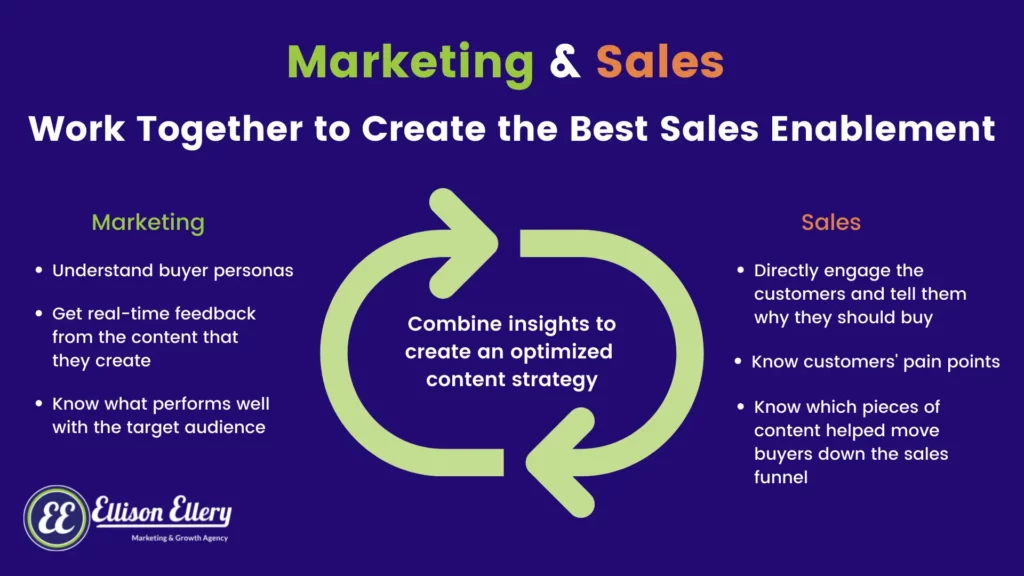
Centralized Location
You can’t just unite the two teams in strategy. You have to make the united insight accessible to everyone, too.
Instead of making individuals wade through all of the noise, you should have a centralized location for all sales content.
Content can be held in any number of places, from Google Docs to a CRM platform. As long as everyone has access to the location and the location is organized in a logical matter, less time will be wasted on sorting through piles of content to find the right stuff.
Not only does a centralized location help salespeople find what they need, it also helps with the performing periodic audits like we discussed above. You’ll know exactly where to find all of the content being used in your sales process.
Making Content Profiles
Sellers and marketers are spread across many different departments, product lines, and regions– especially in larger, multi-faceted organizations. There’s a lot going on!
Sales enablement solutions can cut through all of this clutter, especially when the content gets organized into specific content profiles.
Let’s take a look at what we mean.
In marketing we place huge emphasis on building buyer personas and grouping potential customers by what’s motivating them to make a purchase. If we simply classified people by demographics like age and gender, we’d never be able to create targeted enough content that hits on buyer pain points.
Content profiles are also helpful in a sales enablement strategy. Filtering content by a specific buyer or buyer characteristics effectively reduces the amount of time and energy spent by a salesperson on finding the exact content they need.
A seller in mid conversation with a potential buyer doesn’t have time to go hunting for the infographic or statistic they know will help the buyer make their decision. Especially now, when buyer attention spans have them onto the next thing in a matter of minutes.
If content is already organized into sections based on customer situations, the seller will know exactly where to look. For example, was a previous customer in a similar situation successfully moved down the buyer’s journey after contact with a specific piece of content?
With knowledge of this, and a way to easily find it, the seller is empowered to repeat that same success.
The Benefits of Sales Enablement
We’re not going to lie to you. Sales enablement that works isn’t set up overnight, and it’s going to take some upfront planning (and continuous adjusting) to use.
That’s where we really come in– book a marketing consultation with us to learn how we can help you with your sales enablement strategy.
In the meantime though, we wanted to share with you the tangible benefits of investing in sales enablement training.
Think about this:
How productive can a group with no internal communication be? How confusing might mixed messaging be for potential customers? How much more persuasive and engaging could a properly informed salesperson be? What common sales mistakes could be avoided?
A cohesive, well-connected, and product/service-educated team makes it easier for everyone- employees and customers alike- to efficiently and effectively engage with a brand. Everyone’s aware of the goals and able to make better sales and purchasing decisions.
Here are four key benefits to know about sales enablement and why you should implement a strategy sooner rather than later:
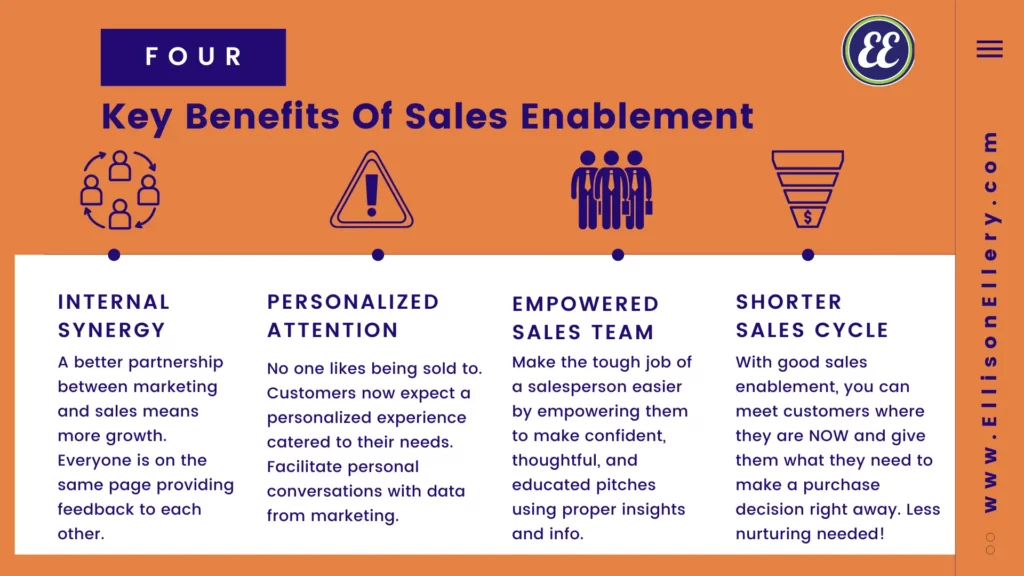
1) Internal Synergy
A better partnership between marketing and sales means better business growth. Everyone is on the same page!
Sales can give marketing teams actionable feedback on content and resources, and marketing can help sales by giving them qualified leads and vital information to seal the deal.
With both groups working together- instead of in silos with no communication- your business will turn more prospects into customers at a more efficient rate. (And meet or exceed revenue goals in the process!)
2) Personalized Attention
It’s a tale as old as time: no one likes being sold to. And now more than ever, customers expect a personalized experience that caters right to their needs and desires.
A salesperson without the right information on a prospective customer simply can’t facilitate a personal, less-sales-pitchy conversation.
With data from marketing research to back up the sales process, there’s more space for organic conversation and empathy with the customers’ journey.
3) An Empowered Sales Team
Salespeople want to make sales, but they didn’t necessarily pick a career that’s a walk in the park. In a world full of endless products and service options, they have to convince the potential customer that this solution is the one for them.
Make their jobs a little bit easier!
Empower them to make confident, thoughtful, and educated pitches by giving them the right information and insights. When armed with good content and resources, salespeople can spend more time on captivating conversations, showing customers exactly how your company can make their lives better.
Learn how to create sales enablement resources for your team and they’ll become unstoppable!
4) Shorter Sales Cycle
You don’t want to throw prospective customers down the sales funnel so fast that you miss the mark, but there are parts of the funnel that many of us could do without. Ask any sales rep- they’ll probably tell you that they spend too much time out of their day on admin work and qualification steps.
A good sales enablement strategy lets your sales rep focus more time on what they do best, and this moves customers down the sales funnel faster leading to quicker revenue growth.
Craft the perfect sales enablement strategy
Not sure if your sales enablement strategy is actually helping your team close sales? We excel in building strategies tailored to your business, and we'll create alignment between your sales and marketing teams through training, technology, and content.
Crafting The Perfect Sales Enablement Strategy
Before now you may not have considered how powerful sales enablement is and the ways it can help your business grow. Let us help you organize your team across marketing and sales and reach your full potential!
At Ellison Ellery, we excel in building strategies tailored to you and your business so that you can grow. We help established businesses create alignment between sales and marketing teams through training, technology, and content.
With the right content and a sales enablement strategy that works for everyone, you can move forward confidently and efficiently – with happier customers (and employees).
